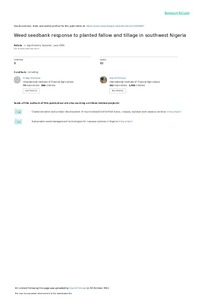| dc.contributor.author | Ekeleme, F. |
| dc.contributor.author | Chikoye, D. |
| dc.contributor.author | Akobundu, I.O. |
| dc.date.accessioned | 2019-12-04T11:23:40Z |
| dc.date.available | 2019-12-04T11:23:40Z |
| dc.date.issued | 2005-06 |
| dc.identifier.citation | Ekeleme, F., Chikoye, D. & Akobundu, I.O. (2005). Weed seedbank response to planted fallow and tillage in southwest Nigeria. Agroforestry Systems, 63(3), 299-306. |
| dc.identifier.issn | 0167-4366 |
| dc.identifier.uri | https://hdl.handle.net/20.500.12478/4104 |
| dc.description.abstract | Planted fallows are an alternative to the unsustainable bush fallow for improved soil and weed management in the tropics. However, the interactive effects of planted fallows and tillage on the weed seedbank are not well documented in the tropical environment. The effect of fallow type and tillage on the weed seedbank in the soil was assessed in 1995 and 1996 at Ibadan, southwest Nigeria. The planted fallow species consisted of a herbaceous legume (Pueraria phaseoloides) and three woody legumes (Acacia auriculiformis, Leucaena leucocephala, and Senna siamea). Natural bush fallow and continuous cassava/maize plots were controls. Tillage treatments were minimum tillage and mounding. Continuous maize/cassava plots had the largest weed seedbank in both years. After six years of continuous fallow, the weed seedbank was 86% lower in A. auriculiformis, 79% in P. phaseoloides, 68% in S. siamea, 53% in L. leucocephala, and 35% in natural bush fallow plots than in continuously cultivated plots. Compared to minimum tillage, mounding reduced the seedbank by 47% in 1995 and 66% in 1996. Redundancy analysis showed that tillage contributed significantly to the variance in species composition. Euphorbia hyssopifolia, E. heterophylla, and Cynodon dactylon showed no preference in terms of tillage. Perennial and annual grasses (Digitaria horizontalis, Eleusine indica, Paspalum orbiculare, Cynodon dactylon) with Cyathula prostrata and Desmodium scorpiurus, an annual and perennial broadleaf, respectively, were most abundant in the seedbank of continuously cultivated plots. There were more annual broadleaf weeds in the seedbank of planted fallow plots than in the control plots. Species diversity of the seedbank was greatest in plots under minimum tillage. Mounding as a seedbed preparation method, especially within the improved fallow system, could reduce the high weed pressure experienced by smallholder farmers in southwest Nigeria. |
| dc.format.extent | 299-306 |
| dc.language.iso | en |
| dc.subject | Bush Fallowing |
| dc.subject | Minimum Tillage |
| dc.subject | Fallow |
| dc.subject | Weeds |
| dc.subject | Cassava |
| dc.subject | Maize |
| dc.title | Weed seedbank response to planted fallow and tillage in southwest Nigeria |
| dc.type | Journal Article |
| dc.description.version | Peer Review |
| cg.contributor.crp | Roots, Tubers and Bananas |
| cg.contributor.affiliation | Michael Okpara University of Agriculture |
| cg.contributor.affiliation | International Institute of Tropical Agriculture |
| cg.contributor.affiliation | Liberty Place, Windsor Mill, USA |
| cg.coverage.region | West Africa |
| cg.coverage.country | Nigeria |
| cg.creator.identifier | Friday Ekeleme: 0000-0001-6178-2606 |
| cg.creator.identifier | David Chikoye: 0000-0002-6047-9821 |
| cg.isijournal | ISI Journal |
| cg.authorship.types | CGIAR and developing country institute |
| cg.iitasubject | Plant Health |
| cg.iitasubject | Plant Production |
| cg.iitasubject | Weeds |
| cg.journal | Agroforestry Systems |
| cg.howpublished | Formally Published |
| cg.accessibilitystatus | Limited Access |
| local.dspaceid | 99535 |
| cg.targetaudience | Scientists |
| cg.identifier.doi | https://dx.doi.org/10.1007/s10457-005-5747-0 |

